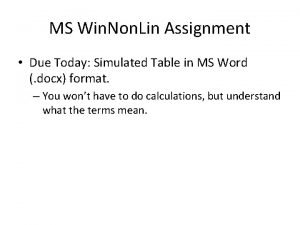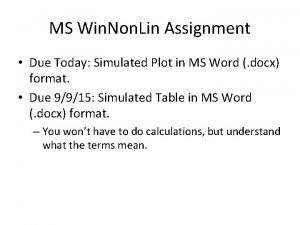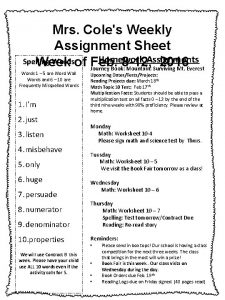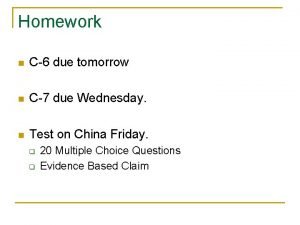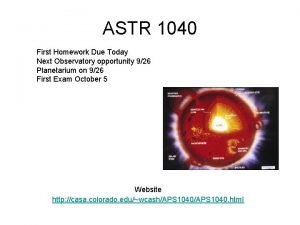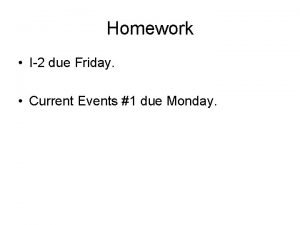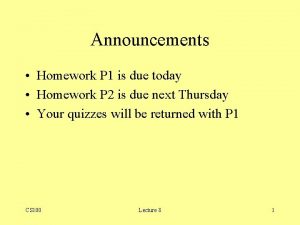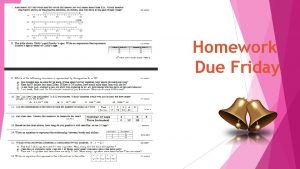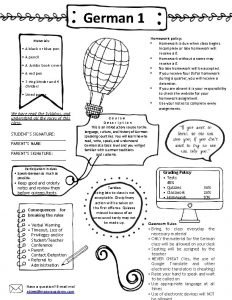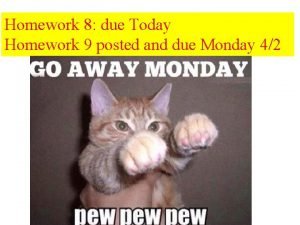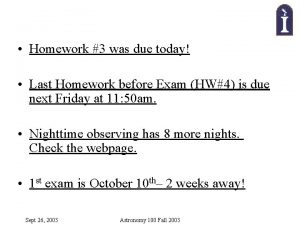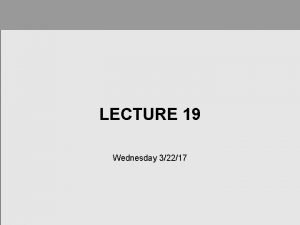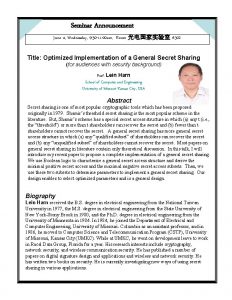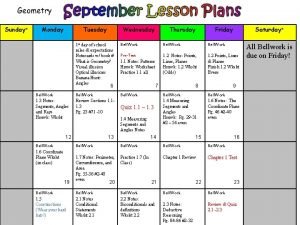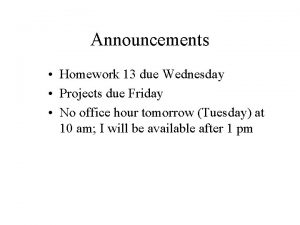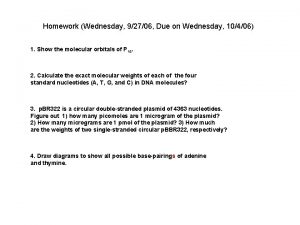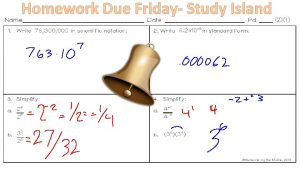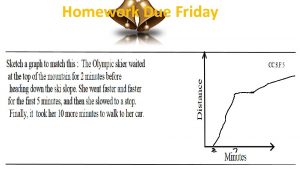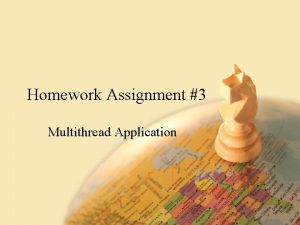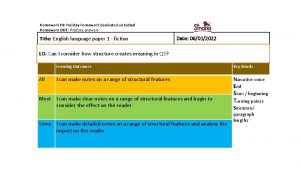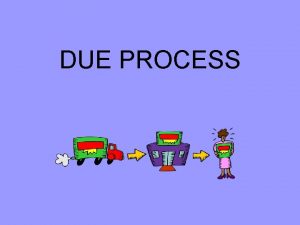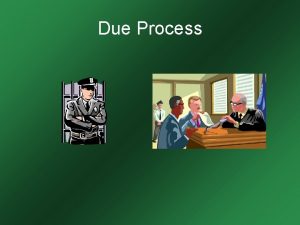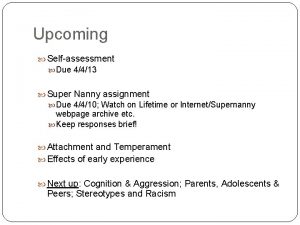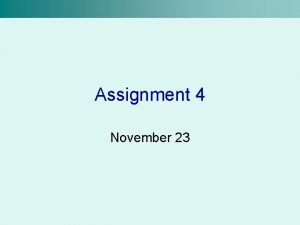Homework Assignment Homework 1 is due Wednesday at


![Sampling Random sampling function sample() { return [random() * width, random() * height]; } Sampling Random sampling function sample() { return [random() * width, random() * height]; }](https://slidetodoc.com/presentation_image/c5294512e9889646ed36cade709a46d1/image-3.jpg)





































- Slides: 40

Homework Assignment: Homework #1 is due Wednesday at 4: 15 PM The assignment is posted at http: //sites. google. com/site/stats 202/homework Follow the instructions on the course website on how to submit homework. The process should be straightforward, but if it is not for some reason, please email us at stats 202@gmail. com.

Sampling Light is a continuous signal -- we perceive it by sampling at various points in space Human retina -- Poisson-disc distribution to avoid occlusion, maintaining a minimum distance between photoreceptors Photo: retinalmicroscopy. com http: //bost. ocks. org/mike/algorith ms/
![Sampling Random sampling function sample return random width random height Sampling Random sampling function sample() { return [random() * width, random() * height]; }](https://slidetodoc.com/presentation_image/c5294512e9889646ed36cade709a46d1/image-3.jpg)
Sampling Random sampling function sample() { return [random() * width, random() * height]; } http: //bost. ocks. org/mike/algorith ms/

Sampling Mitchell’s best-candidate algorithm to create a Poisson disc distribution function sample() { var best. Candidate, best. Distance = 0; for (var i = 0; i < num. Candidates; ++i) { var c = [Math. random() * width, Math. random() * height], d = distance(find. Closest(samples, c); if (d > best. Distance) { best. Distance = d; best. Candidate = c; } } return best. Candidate; http: //bost. ocks. org/mike/algorith ms/

Sampling Mitchell’s best-candidate algorithm to create a Poisson disc distribution http: //bost. ocks. org/mike/algorith ms/

Introduction to Data Mining by Tan, Steinbach, Kumar Chapter 3: Exploring Data

Exploring Data We can explore data visually (using tables or graphs) or numerically (using summary statistics) Section 3. 2 deals with summary statistics Section 3. 3 deals with visualization We will begin with visualization Note that many of the techniques you use to explore data are also useful for presenting data

Visualization Page 105: “Data visualization is the display of information in a graphical or tabular format. Successful visualization requires that the data (information) be converted into a visual format so that the characteristics of the data and the relationships among data items or attributes can be analyzed or reported. The goal of visualization is the interpretation of the visualized information by a person and the formation of a mental model of the information. ”

Example: Below are exam scores from a previous course. Describe this data. 192 160 188 189 184 188 153 190 183 150 183 171 154 169 166 136 163 181 177 151 168 150 162 192 188 125 159 168 165 164 191 192 141 157 181 184 190 149 171 160 Note, this data is at http: //sites. google. com/site/stats 202/data/exam_scores. csv

The Histogram (Page 111): “A plot that displays the distribution of values for attributes by dividing the possible values into bins and showing the number of objects that fall into each bin. ” Page 112 – “A Relative frequency histogram replaces the count by the relative frequency”. These are useful for comparing multiple groups of different sizes. The corresponding table is often called the frequency distribution (or relative frequency distribution). The function “hist” in R is useful.

In class exercise #6: Make a frequency histogram in R for the exam scores using bins of width 10 beginning at 120 and ending at 200.

In class exercise #6: Make a frequency histogram in R for the exam scores using bins of width 10 beginning at 120 and ending at 200. Answer: > exam_scores<read. csv("exam_scores. csv", header=F) > hist(exam_scores[, 1], breaks=seq(120, 200, by=10), col="red", xlab="Exam Scores", ylab="Frequency", main="Exam Score Histogram")

In class exercise #6: Make a frequency histogram in R for the exam scores using bins of width 10 beginning at 120 and ending at 200. Answer:

The Empirical Cumulative Distribution Function (Page 115) “A cumulative distribution function (CDF) shows the probability that a point is less than a value. ” “For each observed value, an empirical cumulative distribution function (ECDF) shows the fraction of points that are less than this value. ” (Page 116) A plot of the ECDF is sometimes called an ogive. The function “ecdf” in R is useful. The plotting features are poorly documented in the help(ecdf) but many examples are given.

In class exercise #7: Make a plot of the ECDF for the exam scores using the function “ecdf” in R.

In class exercise #7: Make a plot of the ECDF for the exam scores using the function “ecdf” in R. Answer: > plot(ecdf(exam_scores[, 1]), verticals= TRUE, do. p = FALSE, main ="ECDF for Exam Scores", xlab="Exam Scores", ylab="Cumulative Percent")

In class exercise #7: Make a plot of the ECDF for the exam scores using the function “ecdf” in R. Answer:

The (Relative) Frequency Polygon Sometimes it is more useful to display the information in a histogram using points connected by lines instead of solid bars. Such a plot is called a (relative) frequency polygon. This is not in the book. The points are placed at the midpoints of the histogram bins and two extra bins with a count of zero are often included at either end for completeness.

Comparing Multiple Distributions If there is a second exam also scored out of 200 points, how will I compare the distribution of these scores to the previous exam scores? 187 143 180 100 180 159 162 146 159 173 151 165 184 170 176 163 185 171 163 170 102 184 181 145 154 110 165 140 153 182 154 150 152 185 140 132 Note, this data is at http: //sites. google. com/site/stats 202/data/more_exam_scores. csv

Comparing Multiple Distributions Histograms can be used, but only if they are relative frequency histograms. Plots of the ECDF are often even more useful, since they can compare all the percentiles simultaneously. These can also use different color/type lines for each group with a legend.

In class exercise #8: Plot the relative frequency polygons for both the first and second exams on the same graph. Provide a legend.

In class exercise #8: Plot the relative frequency polygons for both the first and second exams on the same graph. Provide a legend. Answer: > more_exam_scores<read. csv("more_exam_scores. csv", header=F) > more_hist<- hist(more_exam_scores[, 1], breaks=seq(100, 200, by=10), plot=FALSE) > orig_hist<- hist(exam_scores[, 1], breaks=seq(100, 200, by=10), plot=FALSE) > plot(c(100, more_hist$mids, 200), c(0, more_hist$counts/dim(more_exam_scores)[1], 0), pch=19, xlab="Exam Scores", ylab="Relative Frequency", main="Relative Frequency Polygons", ylim=c(0, . 30)) > lines(c(100, more_hist$mids, 200), c(0, more_hist$counts/dim(more_exam_scores)[1], 0))

In class exercise #8: Plot the relative frequency polygons for both the first and second exams on the same graph. Provide a legend. Answer (Continued): > points(c(100, orig_hist$mids, 200), c(0, orig_hist$counts/dim(exam_scores)[1], 0), col="blue", pch=19) > lines(c(100, orig_hist$mids, 200), c(0, orig_hist$counts/dim(exam_scores)[1], 0), col="blue", lty=1) > legend(110, . 25, c("Exam 2", "Exam 1"), col=c("black", "blue"), lty=c(2, 1), pch=19)

In class exercise #8: Plot the relative frequency polygons for both the first and second exams on the same graph. Provide a legend. Answer (Continued):

In class exercise #9: Plot the ECDF for both the first and second exams on the same graph. Provide a legend.

In class exercise #9: Plot the ECDF for both the first and second exams on the same graph. Provide a legend. Answer: > plot(ecdf(exam_scores[, 1]), verticals= TRUE, do. p = FALSE, main ="ECDF for Exam Scores", xlab="Exam Scores", ylab="Cumulative Percent", xlim=c(100, 200)) > lines(ecdf(more_exam_scores[, 1]), verticals= TRUE, do. p = FALSE, col. h="red", col. v="red", lwd=4) > legend(110, . 6, c("Exam 1", "Exam 2"),

In class exercise #9: Plot the ECDF for both the first and second exams on the same graph. Provide a legend. Answer:

In class exercise #10: Based on the plot of the ECDF for both the first and second exams from the previous exercise, which exam has lower scores in general? How can you tell from the plot?

Visualizing Paired Numeric Data The data at http: //sites. google. com/site/stats 202/data/exams_and_names. csv contains the same exam scores along with an identifier of the student. For visualizing paired numeric data, scatter plots are extremely useful. Use plot() in R. Hint: When the data set has two or more numeric attributes, examining scatter plots of all possible pairs is often useful. The function pairs() in R does this for you. The book calls this a scatter plot matrix (Page 116).

In class exercise #11: Use R to make a scatter plot of the exam scores at http: //sites. google. com/site/stats 202/data/exams_and_names. csv with the first exam on the x-axis and the second exam on the y-axis. Scale the x-axis and y-axis both from 100 to 200. Add the diagonal line (y=x) to the plot. What does this plot reveal?

In class exercise #11: Use R to make a scatter plot of the exam scores at http: //sites. google. com/site/stats 202/data/exams_and_names. csv with the first exam on the x-axis and the second exam on the y-axis. Scale the x-axis and y-axis both from 100 to 200. Add the diagonal line (y=x) to the plot. What does this plot reveal? Answer: data<-read. csv("exams_and_names. csv") plot(data$Exam. 1, data$Exam. 2, xlim=c(100, 200), ylim=c(100, 200), pch=19, main="Exam Scores", xlab="Exam 1", ylab="Exam 2") abline(c(0, 1))

In class exercise #11: Use R to make a scatter plot of the exam scores at http: //sites. google. com/site/stats 202/data/exams_and_names. csv with the first exam on the x-axis and the second exam on the y-axis. Scale the x-axis and y-axis both from 100 to 200. Add the diagonal line (y=x) to the plot. What does this plot reveal? Answer:

Labeling Points on a Scatter Plot The R commands text() and identify() are useful for labeling points on the scatter plot. ●

In class exercise #12: Use the text() command in R to label the points for the students who scored lower than 150 on the first exam. Use the identify command to label the points for the two students who did better on the second exam than the first exam. Use the first column in the data set for the labels.

In class exercise #12: Use the text() command in R to label the points for the students who scored lower than 150 on the first exam. Use the identify command to label the points for the two students who did better on the second exam than the first exam. Use the first column in the data set for the labels. Answer: text(data$Exam. 1[data$Exam. 1<150], data$Exam. 2[data$Exam. 1<150], labels=data$Student[data$Exam. 1<150], adj=1) identify(data$Exam. 1, data$Exam. 2, labels=data$Student)

In class exercise #12: Use the text() command in R to label the points for the students who scored lower than 150 on the first exam. Use the identify command to label the points for the two students who did better on the second exam than the first exam. Use the first column in the data set for the labels.

Adding Noise to a Scatter Plot When both variables are discrete, many points in a scatter plot may be plotted over top of one another, which tends to skew the relationship. A solution is to add a small amount of noise to the points so that they are jittered a little bit. Note: If you have too many points to display cleanly on a scatter plot, sampling may also be helpful.

In class exercise #13: Add noise uniformly distributed on the interval -0. 5 to both the x and y values in the graph in the previous exercise.

In class exercise #13: Add noise uniformly distributed on the interval -0. 5 to both the x and y values in the graph in the previous exercise. Answer: data$Exam. 1<-data$Exam. 1+runif(40)-. 5 data$Exam. 2<-data$Exam. 2+runif(40)-. 5 plot(data$Exam. 1, data$Exam. 2, xlim=c(100, 200), ylim=c(100, 200), pch=19, main="Exam Scores", xlab="Exam 1", ylab="Exam 2") abline(c(0, 1))

In class exercise #13: Add noise uniformly distributed on the interval -0. 5 to both the x and y values in the graph in the previous exercise.
 Liver blood supply diagram
Liver blood supply diagram Assignment due today
Assignment due today Assignment due today
Assignment due today Assignment due today
Assignment due today Due piccole sfere identiche sono sospese a due punti
Due piccole sfere identiche sono sospese a due punti Quadrilatero con 2 lati paralleli
Quadrilatero con 2 lati paralleli Procedural vs substantive due process
Procedural vs substantive due process Due're/due opposti
Due're/due opposti Hungarian method
Hungarian method Weekly homework assignment sheet
Weekly homework assignment sheet Homework due today
Homework due today Ilegalism
Ilegalism Homework due today
Homework due today Homework due today
Homework due today Homework is due on friday
Homework is due on friday Homework
Homework Homework due today
Homework due today Homework is due on friday
Homework is due on friday Homework is due
Homework is due Homework due today
Homework due today Homework due today
Homework due today Thursday prayer
Thursday prayer Marvelous monday terrific tuesday wonderful wednesday
Marvelous monday terrific tuesday wonderful wednesday Skinny wednesday
Skinny wednesday Wise word wednesday
Wise word wednesday Wednesday evening prayer
Wednesday evening prayer Monday=621 tuesday=732 wednesday=933
Monday=621 tuesday=732 wednesday=933 Wednesday morning prayer
Wednesday morning prayer Wednesday lunch
Wednesday lunch Wednesday writing prompts
Wednesday writing prompts Wednesday diary
Wednesday diary Function of lipids
Function of lipids Fe exam results wednesday
Fe exam results wednesday Moday tuesday
Moday tuesday Happy wednesday march
Happy wednesday march Wednesday seminar
Wednesday seminar Monday=621 tuesday=732 wednesday=933
Monday=621 tuesday=732 wednesday=933 Wednesday bell ringer
Wednesday bell ringer Happy wednesday
Happy wednesday Wednesday bell work
Wednesday bell work Pat winlink
Pat winlink
